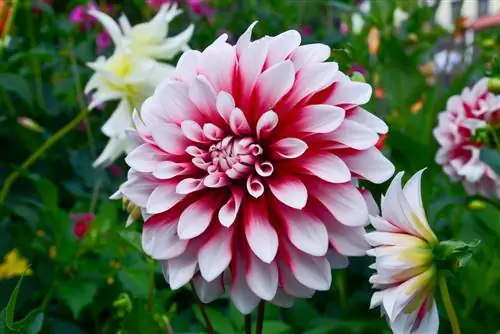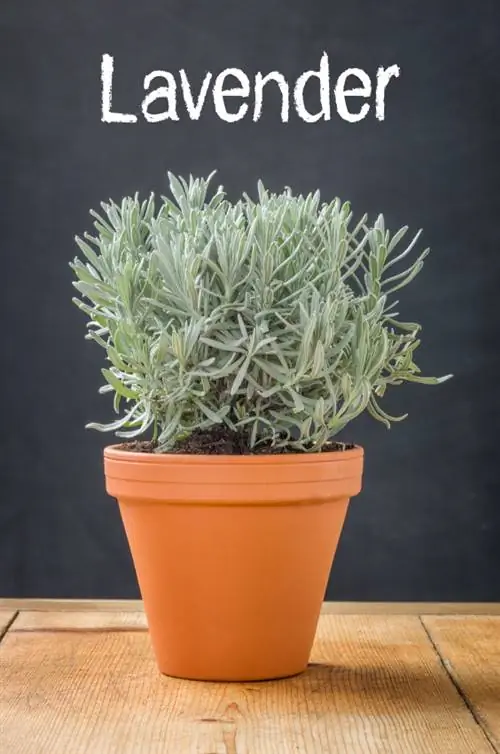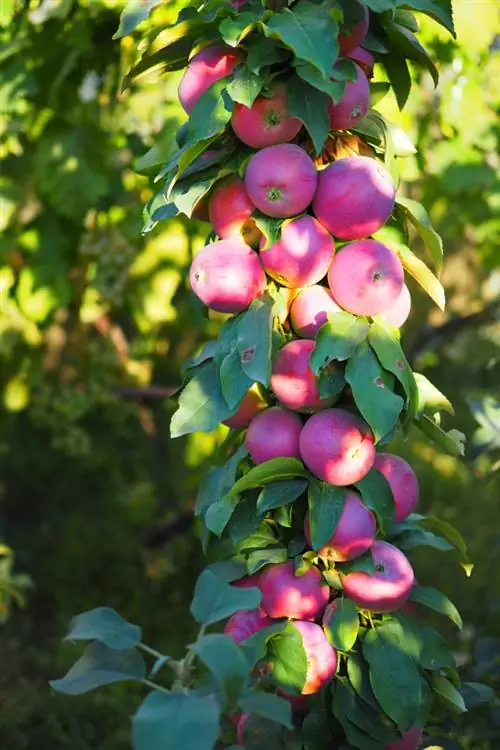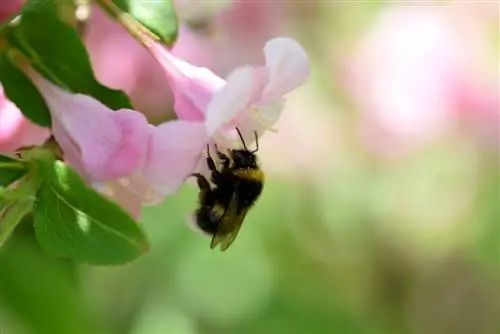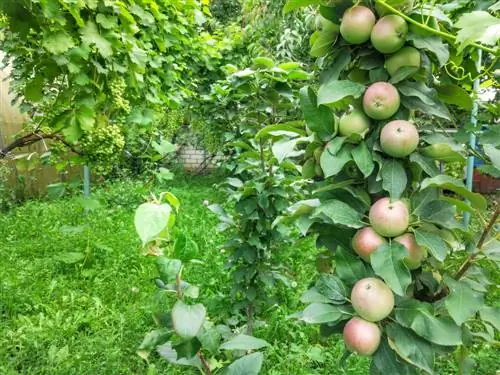- Author admin [email protected].
- Public 2023-12-16 16:46.
- Last modified 2025-01-23 11:21.
Dahlias are undoubtedly one of the most established garden flowers in our latitudes - their usually spherical, lush flowers are simply part of a classic flower garden. Here is an overview of cultivation rules worth knowing and the enormous variety of varieties in this genus.
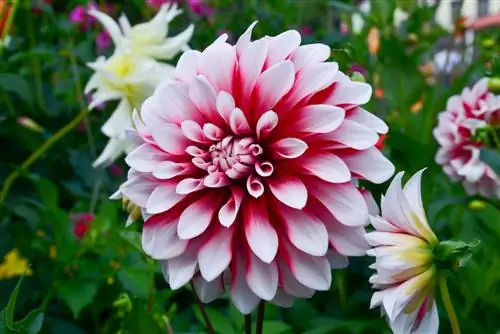
What should you know about dahlias in the garden?
Dahlias are diverse garden flowers with spherical, lush flowers that come in different colors and flower shapes. They prefer sunny, warm locations with nutrient-rich soil and bloom from summer to autumn. Dahlias can be cultivated in beds or pots and propagated by cuttings, division or seeds.
Origin
Dahlias are part of the familiar image of their home region for many people. They have always had a permanent place in the gardens of many generations and are currently experiencing something of a comeback. However, the genus originally comes from very distant lands - the Spaniards discovered it around 500 years ago in the plateaus of Mexico and Guatemala and brought it from there to Europe. Even in their home areas, dahlias were traditionally valued as decorative flowers by the Aztec natives.
Bloom
The flower of the dahlia is certainly the most important thing for the local ornamental garden culture. Spherical, double flowers are most likely associated with dahlias - however, there are many different species within the dahlia genus, some of which also offer completely different flower appearances. In addition to the many lush, double flower types, there are also open, disc-shaped types such as the single-flowering or star dahlias.
The typical and probably most popular double varieties are particularly suitable for bed designs in combination with delicate ornamental grasses or for effective cut flower bouquets. However, due to their heavy, dense abundance of petals, the double varieties tend to bend and may need to be supported by stakes or low hedge transplants.
There are hardly any limits to colors for hobby gardeners these days. The range of countless varieties hardly leaves out a nuance - only deep blue or black varieties are not included.
Flowering time
The flowering period of dahlias varies slightly from variety to variety, but generally they fill the garden with their splendor during the usual flowering period over the summer months. Some varieties show their first flowers as early as June, others not until July. They can persist until autumn until the first frosts.
Which location is suitable?
In the garden, dahlias prefer a location that is as sunny and warm as possible. They also like their feet warm. The soil quality should be nutrient-rich, deep, permeable and not too dry.
Planting out
Because of their relatively high nutrient requirements, you should prepare a humus-rich substrate for dahlias. Work plenty of compost, horn shavings and, if possible, stable manure into the soil at the planned planting site. When planting the individual tubers, you should maintain a distance of around 50 and 80 centimeters - depending on how large the variety grows. Place them in the soil at approximately twice the height of the tubers. For better germination, you can soak the tubers in water two days before planting.
What is the best time to plant?
Dahlias are planted in late spring, after the last danger of frost has passed - i.e. after the Ice Saints. This applies to both annual and perennial varieties.
Dahlia in a pot
If you don't have extensive beds available, you don't have to do without dahlias. They can also be easily cultivated in pots on a terrace or balcony. This even has several advantages:
- Early flowering: If you keep the dahlias in pots anyway, you can get them used to the emerging light from early spring and get them to bloom early at the end of May.
- Mobility and easy overwintering: You can place your dahlias in the pot anywhere on the terrace, on the balcony or on seats in the garden. Of course, as long as the place is sunny. A bucket of colorful dahlias is always a summery, enhancing decoration for an enjoyable stay in your own oasis. In addition, the overwintering procedure is of course made much easier - instead of having to laboriously dig up the tubers and store them, you just need to put the dahlia pot in the house when frost hits.
- Less risk of rot and snails: In the bed, dahlias tend to rot in very wet weather. This is difficult to prevent if there is a fixed planting location in the bed. However, if you keep your dahlias in a pot, you can determine their water supply yourself and only water them enough to keep them moderately moist. Snails are also easier to keep under control when grown in containers. Standing on the terrace, the voracious pests tend to stay away from your dahlias anyway - plus, with tuff in the pot, you have a better overview of the plants.
The substrate in the pot should, like in the bed, be nutrient-rich. It should also have a lot of volume - so use the largest possible planter. You can also enrich the soil with compost and horn shavings for the long-term care of the heavy-feeding dahlias. In addition, they should be fertilized regularly with a - this can be done very easily in the bucket with a normal liquid fertilizer once a week.
Wintering
Dahlias are not frost hardy due to their habitat of origin. Separate wintering is therefore necessary in our latitudes. When growing in beds, the tubers must be dug up and stored. In autumn, wait until the flowers have lost all their leaves and then dig up the tubers with the digging fork. Then let them dry for a few days so that they don't rot when stored and then place them in a box filled with sand. Place them in a cool, dry place - for example in an unheated basement. The temperature should be around 5°C.
To remember:
- Allow dahlias to fall off completely in autumn
- Then dig up the tubers and let them dry
- Store in a box filled with sand and place in a cool place around 5°C
Fertilize dahlia properly
In the bed, dahlias are best supplied with long-term organic fertilizer when planting, i.e. by mixing mature compost, stable manure and/or horn shavings into the soil. If you keep your dahlias in a pot, you should provide them with a universal fertilizer every week during the growing phase throughout the summer.
Advance
Preferring dahlias can be worthwhile if you don't want to wait too long for them to bloom in summer. They often bloom significantly earlier with an early spring phase. To do this, put the tubers in pots from the end of February and place them on the windowsill. From May 15th you can put them outside in the bed and look forward to a splendor of flowers soon.
Propagate Dahlia
Dahlias are best propagated via cuttings or division. With the cutting method you have the advantage of a higher yield. Each tuber has a capacity of around 10 to 20 shoots suitable for cuttings.
To get cuttings, you have to plant the tubers early in the year, ideally at the end of January. To do this, place them in pots with potting soil and leave the shoot buds exposed. Keep the soil (€18.00 at Amazon) well moist and ensure an ambient temperature of around 15 to 20°C.
If the tuber has formed shoots after 2 to 3 weeks, simply cut them off with a clean knife and place them in their own pots with potting soil and a little rooting powder. It is best to cover the cutting pots with foil so that they can thrive in a warm, evenly moist microclimate. Rooting takes about two weeks. After gradually getting used to cooler temperatures and more irregular humidity, you can then put the young dahlias in the bed as usual from the Ice Saints onwards.
The cutting method at a glance:
- Advance tuber from the end of January
- To do this, place in potting soil with the shoot bud exposed
- Cut off shoots and place them in pots with potting soil
- Allow to root under even moisture and in warm, bright conditions
- Plant out from the end of May
Share
The much simpler but not quite as productive propagation method is dividing the tubers. To do this, cut a tuber in half before planting in May and make sure that each section has an eye capable of sprouting.
Pull
Lastly, dahlias can also be grown from a seed. You can either buy seeds from specialist retailers or collect them from your own plants in the garden. However, you have to pay close attention to the right time. After flowering, the seed coat will burst open on its own at some point - a sign that the seeds it contains are now ready to germinate.
Carefully collect the seeds and store them over the winter. You can then sow from March in a room with a temperature of 18 to 20°C in a bright window seat. Keep the seeds, lightly covered with soil, evenly moist in the seed trays, possibly under foil. They should germinate after about 10 days. From April you can separate them and plant them outside in May after the Ice Saints.
When you grow seeds, you don't get a clone of the mother plant. It is possible that the daughter plants will have different flower colors. It is precisely this surprise effect that is particularly attractive for many hobby gardeners and a real challenge for breeding experiments.
Tip
If you want to achieve a special abundance of flowers from your dahlias, you can tweeze them about 10 days after planting. By cutting off the individual shoot tips, the plant is encouraged to branch further and thus multiply the flowers. You should always cut off spent flowers straight away to encourage new flower growth.
Varieties
Dahlias are an extremely diverse genus. Four sections and a total of around 35 species are systematically distinguished. However, only the Dahlia section is actually relevant to local garden culture. The others, Dahlia Pseudodendron, Epiphytum and Entemophyllon, have some liana-like or very high growth characteristics that are unsuitable for beds.
The Dahlia section includes 25 species of its own. There are now thousands of different varieties with countless flower shapes and colors. For the purpose of a better overview, they are further divided into 15 separate variety groups or classes, which are primarily based on the appearance of the flowers. The classes therefore often have names based on other plant flowers, such as the anemone-flowered or the orchid-flowered dahlias.
Here is a selection from the 15 variety groups, each with an example of a variety:
Ball Dahlias
As the name suggests, the varieties of this dahlia class have spherical flowers. They are a real classic among dahlias and are an indispensable part of traditional flower gardens. Ball dahlias have vigorous growth and reach a height of around 100 to 140 cm. The class includes a very colorful variety with delicate nude tones through to strong, radiant summer colors or even multi-colored structures.
The Eveline variety, for example, has a white color with delicate violet shades, while the Golden Torch variety has a rich, sunny yellow flower ball. Fans of sophisticated color play within the flowers may like the Jowey Joshua variety with its brick-red coloring with a cream-colored center.
Pompon Dahlias
Characteristic of this class are the pompom-shaped, spherical, double inflorescences. They are therefore quite similar to ball dahlias, but are not quite as big at around 80 to 100 cm. The neatly structured flower balls on the individual stems create a very decorative picture. The different varieties can have very different colors - the Lipoma variety, for example, appears in romantic old pink to lilac colors from June onwards and is also ideal as a cut flower.
Cactus Dahlias
With this variety, all hobby gardeners who have a penchant for more exotic flower structures will get their money's worth. Because the cactus dahlias, with their many spherically arranged, tapered petals, create a somewhat less classically rural and rather more sophisticated image. In some varieties, the prickly-looking petal structure is emphasized by a color transition at the petal tips - for example in the Jessica variety, in which the lemon yellow center turns into a contrasting scarlet red at the ends.
Deer Antler Dahlias
The deer antler dahlias also have a particularly attractive flower structure with very numerous, densely packed and narrow-pointed petals, which sometimes appear very delicate and fringed, depending on the variety. Here, too, there are a few different color variants with contrasting tinted petal tips, such as the Anna Marie variety with a white heart and pink ends.
Star Dahlias
This variety has a slightly less lush inflorescence - with only a few, narrow petals in an even star arrangement, they have a much more delicate appearance than the many voluminous, double varieties. The flowers have a diameter of around 8 centimeters and the star dahlias reach a height of a meter. The Honka variety is a particularly distinctive representative of the star dahlias thanks to its sunny yellow color with an orange pistil.
Single-blooming dahlias
The eponymous simplicity of this class lies in the picture-perfect appearance of its open tubular flowers, usually with 8 clear, egg-shaped petals. Thanks to this open, easily accessible flower shape, the single-flowering dahlias are not only a feast for our eyes, but also for nectar-collecting insects such as bumblebees and bees. Their pollen supply is also very rich. The height of growth varies considerably within the class from a very low 30 to around 150 centimeters for hedge dahlias.
The Carnelian variety is one of the best-known single-flowering dahlias and features bright red petals with slightly fading tips around a rich yellow center.

